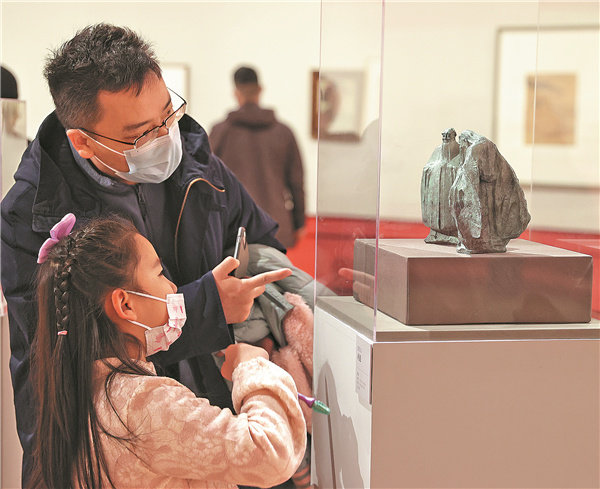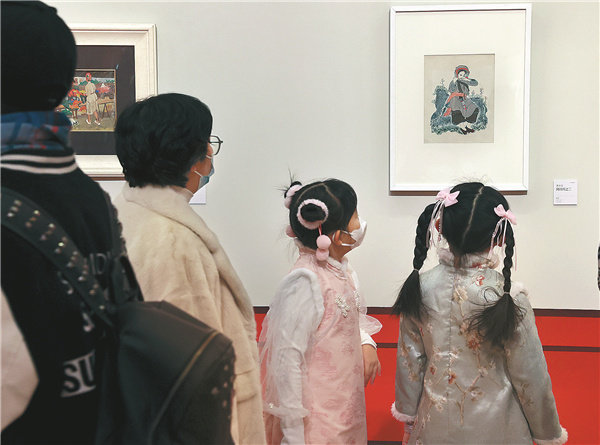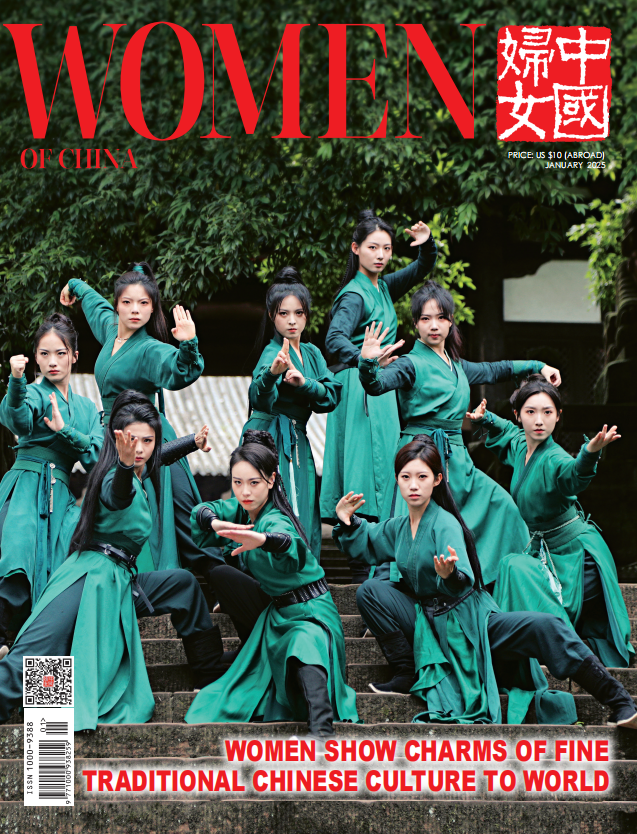Small Is Beautiful
 |
| Visitors attend Beauty in Greatness Through Details, an ongoing exhibition at the National Art Museum of China, appreciating exhibits such as Seeking Truth, a sculpture by Wu Weishan, and Ashima, a print by Huang Yongyu. [Photo by Jiang Dong/China Daily] |
Works that are modest in size or even tiny can have huge consequences as shown by an exhibition at the National Art Museum of China, Lin Qi reports.
An artwork measuring just a few centimeters has within it the power to reveal to an audience all the manifestations of nature and rules of the universe.
One famous example of this is Girl With a Pearl Earring, the portrait by the 17th-century Dutch artist Johannes Vermeer. It is sometimes called the "Dutch Mona Lisa" for the enigmatic gaze of the girl being depicted, as well as her unknown identity, which bears similarities to that of Leonardo da Vinci's work.
Housed in the Mauritshuis museum in The Hague, Girl With a Pearl Earring stands only 44.5 centimeters by 39 cm in size.
The artist produced relatively few pieces in his lifetime, and it is arguably the most celebrated work in Vermeer's oeuvre.
The painting's global popularity shows that the creativity of an artist and their exploration of detail and brushwork are not confined by the dimensions of their work.
Beauty in Greatness Through Details, an exhibition running at the National Art Museum of China until March 26, offers viewers a glimpse of the extensive universe that painters and sculptors have created in the production of small works.
The show features 1,000 exhibits — paintings, prints, watercolors and sculptures — from not just the Beijing museum's own collection, but prominent artists and a nationwide search for relevant works. The smallest pieces on display are about the size of a postage stamp, while the largest are no bigger than 60 cm.
 |
| Visitors attend Beauty in Greatness Through Details, an ongoing exhibition at the National Art Museum of China, appreciating exhibits such as Seeking Truth, a sculpture by Wu Weishan. [Photo by Jiang Dong/China Daily] |
Wu Weishan, director of the National Art Museum of China, says they mounted the exhibition to address a noticeable trend in artistic creation of recent years, where more works of large and even huge dimensions have been created; and they hope that via this exhibition, people will also find, in smaller works, the beauty and richness of the world.
"Laozi, the ancient Taoist philosopher, was quoted as saying, 'Governing a big country requires the same delicacy as cooking a small fish.' The rules of creation are alike," Wu says. "Only when someone makes an effort to achieve exquisiteness in detail and within limited dimensions, can they reveal the scope and depth of the world."
Works at the exhibition feature iconic motifs and styles, having been revisited by those celebrated figures of the 20th century, for example, Salted Preserved Eggs and Insect by Qi Baishi, who is known for pairing food and small animals in his work to deliver a casual, peaceful mood; Two Lions by Xu Beihong who often depicted noble beasts like lions, tigers and eagles to lift people's morale in the time of difficulty; and Shushan Mountain by Huang Binhong, whose highly personalized brushwork saw him acclaimed as one of the greatest landscape painters in modern China.
The exhibition also shows recent works, in which artists address the changes in ordinary people's lives and perceptions, such as First Snow by Huang Huasan that hails deliverymen in cities whose hard work, especially during the pandemic lockdowns, was vital to urban dwellers.
Wu says that through the works, people will see the evolution in the styles of artists from different stages of history, as well as the changing bigger picture via the small details.
 |
| Visitors attend Beauty in Greatness Through Details, an ongoing exhibition at the National Art Museum of China, appreciating exhibits such as Ashima, a print by Huang Yongyu. [Photo by Jiang Dong/China Daily] |
"The small works show diverse life experiences, an intimate relationship with nature and a love of people, reflecting social concerns and history. The underlying thought and emotions come before the size of a work," he says.
The exhibition is the first of a series of curated themed shows this year to celebrate the 60th anniversary of the National Art Museum of China. The main building is a mixture of the classic styles of Chinese and modern architecture and construction began in 1958, with the museum opening to the public five years later.
Its name plaque is inscribed with writing by Chairman Mao Zedong and, over the course of the subsequent decades, the museum has accumulated a collection exceeding 130,000 objects of varying types.
Wu says accomplishing refinement and immensity is also a longstanding pursuit of the museum.
(Source: China Daily)
Please understand that womenofchina.cn,a non-profit, information-communication website, cannot reach every writer before using articles and images. For copyright issues, please contact us by emailing: website@womenofchina.cn. The articles published and opinions expressed on this website represent the opinions of writers and are not necessarily shared by womenofchina.cn.






.jpg)

 WeChat
WeChat Weibo
Weibo 京公网安备 11010102004314号
京公网安备 11010102004314号